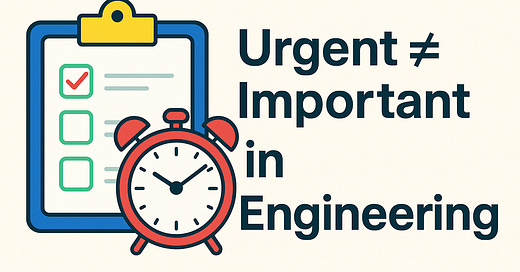Urgent ≠ Important in Engineering
How the constant pressure to react can derail meaningful progress
In software engineering, urgency is visible. It arrives as pings, alerts, last-minute asks or (sometimes) looming deadlines. It creates a sense of momentum, often mistaken for productivity. But urgency doesn’t always equal importance.
Some of the most valuable work in engineering is neither loud nor time-sensitive but it's quietly foundational. When we don’t create space for it, we trade long-term progress for short-term relief.
Overlapping yet Diverging worlds of “Urgent” and “Important”
Let’s be clear: urgent tasks are not unimportant. A broken deployment pipeline or data quality issue needs timely attention.
Engineers are often judged by what’s visible:
Tickets closed
Bugs fixed
Issues triaged
But what about:
Designing systems that avoid those bugs in the first place?
Refactoring a fragile codebase so the next engineer doesn’t hit the same wall?
Investing time in documenting decisions or mentoring a junior dev?
These tasks rarely feel “urgent” but they are undoubtedly important and without them, urgent issues become recurring ones.
Why We Gravitate to Urgent Work
There are reasons we lean toward urgency (first):
It’s easy to justify. There's immediate feedback and recognition.
It’s visible. Fixing a bug or responding to an incident is trackable and celebrated.
It’s safe. No one questions why you're working on something “critical.”
But if we never carve out time for what's important but quiet, we create a loop where only visible problems get solved and systemic issues are left to fester.
Eisenhower Matrix, Applied to Engineering
Quadrant 1: Urgent + Important (Do First)
Actual production outages affecting core user functionality
Security breaches or active vulnerability exploitation
Data corruption or loss incidents
Critical infrastructure failures preventing deployments
That’s a real deal. Drop everything, but also ask why we're here.
Quadrant 2: Important but Not Urgent (Schedule)
System design reviews for implementation and future scale
Technical debt cleanup and refactoring
Performance optimization before it becomes critical
Documentation and knowledge sharing
Automated testing and CI/CD improvements
This is where engineering excellence lives. Protect this time fiercely.
Quadrant 3: Urgent but Not Important (Delegate/Minimize)
Minor bugs affecting edge cases
Meetings that could have been emails
Cosmetic issues that don't impact functionality
Last-minute feature requests without business justification
The urgency imposters. Question everything here.
Quadrant 4: Neither Urgent nor Important (Eliminate)
Endless dashboard tweaks no one asked for
Over-engineering solutions for future non-existing problems
Meetings about meetings
The time vampires. Say no without guilt.
Art of Saying No to Fake Urgency
Not all urgent requests are created equal. Learning to distinguish between real urgency and manufactured urgency is a crucial engineering leadership skill.
Ask the Right Questions:
What happens if we address this tomorrow instead of today?
Who is actually impacted, and how severely?
Is this urgent because of poor planning or a genuine emergency?
Will fixing this urgent item prevent us from addressing its root cause?
What Shifting Focus Actually Looks Like
Shifting the focus doesn't mean ignoring urgency. It means balancing responsiveness with responsibility.
Some ways teams make this shift:
Create Urgency Criteria: Establish clear criteria for what constitutes a genuine emergency. Share these criteria with stakeholders so everyone understands when the "urgent" label is appropriate.
Build Buffers: Reserve capacity for genuine emergencies, specially when your project is on Hypercare mode.
Stakeholder Education: Help product managers and executives understand the relationship between important work and business outcomes. Tip - discuss with numbers (to get buy-in).
Saying no (or not now): Being intentional about which urgent asks truly align with team goals.
Closing Thought
This isn’t about slowing down. It’s about reducing the friction that makes us constantly chase the urgent, while missing the structural issues that keep causing those emergencies.
Trick is to identify and address right tasks, follow Eisenhower Matrix to act on those accordingly.
Apology for short ending notes, my manager is calling with an urgent request.🏃♂️
Until next time, Cheers.
What's one important but neglected piece of work in your current project? How might dedicating consistent time to it change your team's relationship with urgency? Join in conversation on LinkedIn and 𝕏
💌 Love this article? Subscribe to TechParadox.dev for your weekly dose of tech reality checks.
And if you find this newsletter useful and you want to contribute to sustain and evolve it, please think to "buy a coffee"






Hey! Your post caught my eye on my homepage and I just wanted to send some support your way. Whenever you have a moment I’d be grateful if you could check out my latest newsletter. I’m always happy to support and lift each other up!